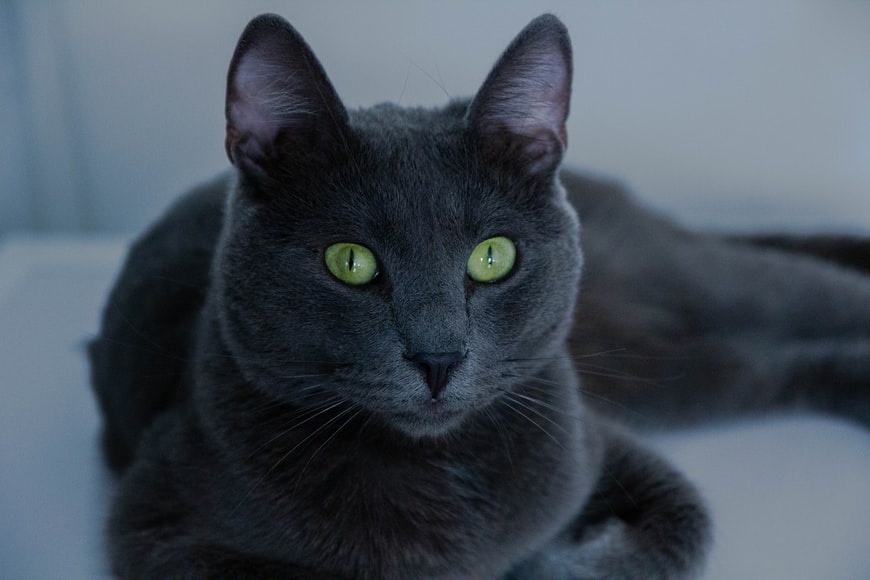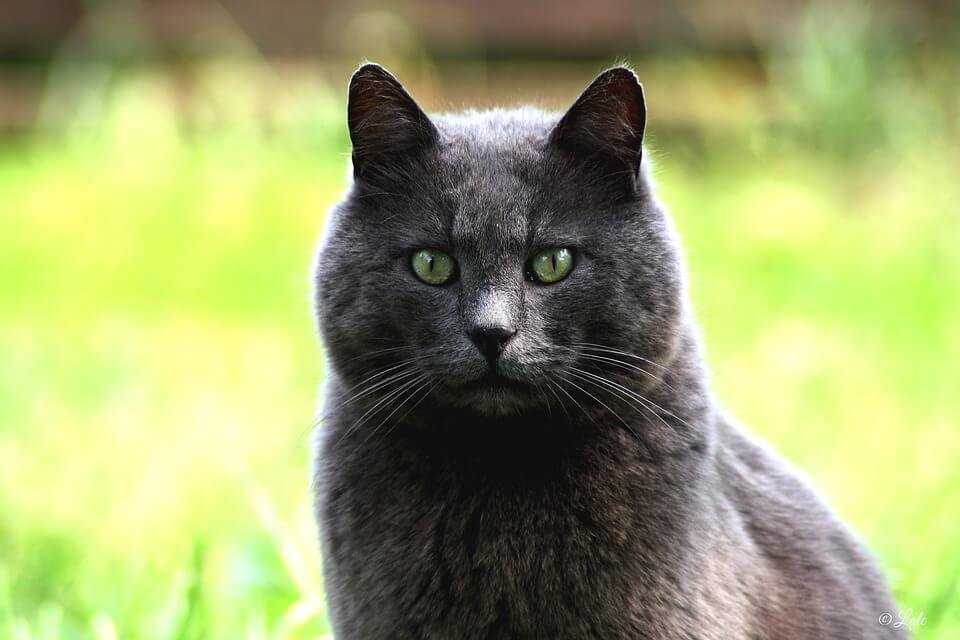Russian Blue
The Russian Blue is one of the most sought-after gray cat breeds, and many people want one in their households. The lovely Russian Blue would be a wonderful addition to nearly any cat-loving home. You'll find it tough to turn away once you've seen one. These stunning felines have a singular beauty and make excellent companions.
Weight
- Male: 7-15 lbs
- Female: 7-15 lbs
Height
- Male 8-12 inches
- Female 8-12 inches
Lifespan
- 10-15 years
Appearance

This breed's general physical shape is athletic and elegant. The bones are fine, and the body is somewhat extended while remaining balanced. The heads are wedge-shaped in general, although not to the extreme. The Russian Blue is distinguished from other breeds by two characteristics. The first is his coat. It's a stunning blue/gray color with just enough silver tips to give it a lustrous shine. The coat is medium in length, incredibly soft, and dense enough to stand on end. Unlike other breeds noted for their magnificent coats, like Persians and Maine Coons, the Russian Blue's coat is very easy to maintain, and weekly brushing is typically all that is required to keep things looking nice. The eyes of this breed are another distinguishing feature. They have a deep emerald green hue at their finest, which contrasts well with their shiny blue fur. The eyes are round, of average size, and nicely spaced.
Temperament
This breed is much more than its appearance. The Russian Blue is a kind and loving companion that is anxious to please his owner. While your Blue will devote his entire life to you, don't expect him to make friends with everyone. Strangers are known to make this breed nervous. It's not uncommon for him to flee and hide when he sees someone he doesn't recognize.
The Russian Blue is said to be suitable to be around youngsters. This is not an aggressive cat breed, and he will flee and hide if he does not like how a youngster is playing with him. The Russian Blue is a smart cat that is simple to teach.
The Russian Blue has several characteristics that distinguish it as a unique addition to any household. They aren't exaggerated or ostentatious in any way. They are intelligent, compassionate, and loving. You'll have to put in some effort to help them come out of their shell, but Russian blue owners swear it'll be time well spent.
The most endearing aspect of the Russian Blue's nature is its affection for humans—their people. If you have a Russian Blue, don't be shocked if they grow connected to one of your family members. Although the Russian Blue may appear to show partiality, they will adore everyone in the household equally and be as loving.
Anyone who has owned a Russian Blue can attest to the truth of the legends: the Russian Blue will train you rather than you training them. This clever little cat must be aware of how adorable they are and how to make the most of it.
The Russian Blue is quite pleased to sleep alone in a snug little hiding nook in your house. They may also act in this manner if you have uninvited visitors to your house.
Living Conditions

Russian Blue are very clever creatures who demand constant physical and mental stimulation; therefore, toys should always be available. They still have a strong hunting instinct; therefore, a toy fishing pole with feathers is ideal. Because your cat may rip it to bits, and he may eat the feathers and thread, neither of which is beneficial for his digestive system or overall health, consider putting these sorts of toys in a cat-proof location.
Your Russian Blue will only require little grooming and treatment if you follow a decent cleanliness regimen. Investing in a toothbrush and safe cat toothpaste to keep his teeth clean and white, as well as a medium-toothed comb to maintain his double coat smooth and luscious, are all essential things for keeping your cat comfortable after adoption. One crucial fact about the Russian Blue is that these cats enjoy eating, so make sure he doesn't overeat. He'll most likely ask for food several times a day, but be firm and adhere to a regular feeding plan, using measured portions of cat food and avoiding too many cat treats.
Russian blues are talkative cats who use their voices to communicate with their pet parents when they want to play, eat, or love. They are vigilant and persistent, making sure they are satisfied at all times. Expect to hear about it because they don't adjust well to change, such as different meal times or unfamiliar guests. If you communicate with Russian Blue daily, and your Russian Blue replies favorably, it means you're never truly alone when you own one of these cats.
Care

The grooming requirements of the Russian Blue are fairly modest. To get rid of loose hairs and keep shedding to a minimum, these cats need a weekly brushing and a few baths. Nail trimming eye and ear cleaning should all be done regularly. These cats don't require any particular exercise since, like other cats, they will expend a lot of energy playing and racing about the home. You may assist your Russian Blue by placing some toys out for him to play with. Because the Russian Blue has an inherent desire to hunt, a feather play or fishing-pole toy is ideal for encouraging physical and mental activity.
The Russian Blue is an intelligent cat breed that responds well to training. Although lots of praise and stroking are always excellent training techniques, teaching your cat to utilize a litter box and scratching post should be simple.
This breed is highly talkative and enjoys having back-and-forth discussions with housemates or pet parents, but it lives on regularity and is not easily adapted to change. Try to keep mealtimes and playtimes on a regular schedule. And feed your Russian blue high-quality cat food and keep track of how much he eats to avoid obesity, which is a problem for this breed. Consult your veterinarian to determine how much and how often to feed your cat.
Health
The lifetime of Russian blues is 15–20 years. These cats are a naturally occurring breed that contributes to their typically good health. To maintain a Russian Blue in excellent shape, all that is necessary is regular exercise and a balanced diet.
This breed does enjoy eating and may develop obesity and progressive retinal atrophy (PRA), a degenerative degeneration of the retina or optical center of the eye. They can also develop polycystic kidney disease (PKD), which causes the kidneys to become clogged with fluid-filled gaps, preventing them from operating properly.
History

Although little is known about this uncommon cat breed,it is said to have originated in northern Russia, especially the Archangel Isles. According to the Cat Fanciers' Association (CFA), the Cat legend says that The Russian Blue breed is derived from the Russian Czars' cats. If the Russian Blue moved from northern Russia in the mid-1860s, it was most likely via ship to England and northern Europe. Trade ships traveled between this land and the British Isles as early as the sixteenth century, and the Vikings were active in both regions centuries before that. Yet, the Russian blue cat is not mentioned until the nineteenth century.
According to the CFA, the Russian Blue had its first public appearance in 1875, when it was displayed as the "Archangel Cat" in London's Crystal Palace. The Crystal Palace was built under the direction of Prince Albert, Queen Victoria's husband, as the site of The Great Exhibition in 1851. It was afterward used to show things of interest (both live and non-living) to the inhabitants of Victorian London, with worldwide appeal. "Cat displays" had become a regular and popular event by the middle of the nineteenth century.
With its sleek, elegant attitude, it's no wonder that such a dignified cat has royal ancestors. After its arrival to the United States in the early 1900s, the Russian Blue was awarded its categorization by 1912, despite being shown among other blue cats. According to the CFA, the breed truly took hold of pet lovers' hearts after WWII, and it has been gradually increasing in popularity since the 1960s.
Final Thoughts
The Russian Blue is a lovable feline that would make a wonderful addition to any household. They also shed very little, making them ideal for cat lovers with mild cat allergies. When you bring a Russian Blue, formerly known as the Archangel Cat, into your household, you will never feel lonely or unwanted. They adore their family and are easily bonded to all of them, but one may be more than the others at times.
Families with children will enjoy the companionship of the Russian Blue, as they are constantly looking for a fun playmate. Or maybe simply someone to accompany them about the house as they go about their daily routine. The Russian Blue is a magnificent cat with a regal pedigree that will make virtually any household pleased to have them in their home.








Comments